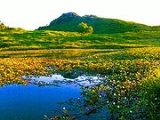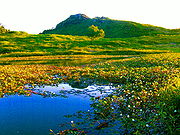
Agreste
Encyclopedia

Brazil
Brazil , officially the Federative Republic of Brazil , is the largest country in South America. It is the world's fifth largest country, both by geographical area and by population with over 192 million people...
, the agreste (aˈɡɾɛʃtʃi) is a narrow zone in the states of Paraíba
Paraíba
Paraíba Paraíba Paraíba (Tupi: pa'ra a'íba: "bad to navigation"; Brazilian Portuguese pronunciation: is a state of Brazil. It is located in the Brazilian Northeast, and is bordered by Rio Grande do Norte to the north, Ceará to the west, Pernambuco to the south and the Atlantic Ocean to the east...
, Pernambuco
Pernambuco
Pernambuco is a state of Brazil, located in the Northeast region of the country. To the north are the states of Paraíba and Ceará, to the west is Piauí, to the south are Alagoas and Bahia, and to the east is the Atlantic Ocean. There are about of beaches, some of the most beautiful in the...
, Alagoas
Alagoas
Alagoas is one of the 27 federative units of Brazil and is situated in the eastern part of the Northeast Region. It borders: Pernambuco ; Sergipe ; Bahia ; and the Atlantic Ocean . It occupies an area of 27,767 km², being slightly larger than Haiti...
, Sergipe
Sergipe
Sergipe , is the smallest state of the Brazilian Federation, located on the northeastern Atlantic coast of the country. It borders on two other states, Bahia to the south and west and Alagoas to the north, and to the east is the Atlantic Ocean...
and Bahia
Bahia
Bahia is one of the 26 states of Brazil, and is located in the northeastern part of the country on the Atlantic coast. It is the fourth most populous Brazilian state after São Paulo, Minas Gerais and Rio de Janeiro, and the fifth-largest in size...
between the coastal forest zona da mata
Zona da Mata (coastal)
The Zona da Mata is the narrow coastal plain between the Atlantic Ocean and the dry agreste and sertão regions in the northeastern Brazilian states of Maranhão, Piauí, Rio Grande do Norte, Paraíba, Pernambuco, Alagoas, Sergipe and Bahia....
and the semiarid sertão
Sertão
In Portuguese, the word sertão first referred to the vast hinterlands of Asia that Lusitanian explorers encountered. In Brazil, the geographical term referred to backlands away from the Atlantic coastal regions where the Portuguese first settled in South America in the early sixteenth century...
. The agreste actually fades out before Rio Grande do Norte
Rio Grande do Norte
Rio Grande do Norte is one of the states of Brazil, located in the northeastern region of the country, occupying the northeasternmost tip of the South American continent. Because of its geographic position, Rio Grande do Norte has a strategic importance. The capital and largest city is Natal...
is reached owing to the breakdown of the mountain chain that gives the coastal Atlantic forest zone
Zona da Mata (coastal)
The Zona da Mata is the narrow coastal plain between the Atlantic Ocean and the dry agreste and sertão regions in the northeastern Brazilian states of Maranhão, Piauí, Rio Grande do Norte, Paraíba, Pernambuco, Alagoas, Sergipe and Bahia....
high rainfall.
Most of the agreste is hilly, with the hills becoming higher in the south, except near the narrow valley of the São Francisco River. Land use is predominantly mixed farming, with fruits such as melons especially important. Like the sertão, the agreste is frequently affected by drought
Drought
A drought is an extended period of months or years when a region notes a deficiency in its water supply. Generally, this occurs when a region receives consistently below average precipitation. It can have a substantial impact on the ecosystem and agriculture of the affected region...
, though generally the effects are less severe.
Climate
The climate is hot and sub-humid, with rainfall in the area's principal city of Campina GrandeCampina Grande
Campina Grande is the second most populous Brazilian city in the State of Paraíba after João Pessoa, the capital. It is considered to be the most important city of the Northeastern Brazilian subregion called agreste. It is considered one of the main industrial, technological and educational...
averaging about 700 millimetres per year - ranging from less than 10 millimetres in October and November to about 120 millimetres in May and June.
See also
- Brazil Socio-Geographic DivisionBrazil Socio-Geographic DivisionThe Brazil socio-geographic division is a slightly different division than the Brazilian Division by Regions. It separates the country into three different and distinctive regions:*Amazônia Legal*Centro-Sul*Nordeste...
- SertãoSertãoIn Portuguese, the word sertão first referred to the vast hinterlands of Asia that Lusitanian explorers encountered. In Brazil, the geographical term referred to backlands away from the Atlantic coastal regions where the Portuguese first settled in South America in the early sixteenth century...
- Tieta do AgresteTieta do AgresteTieta do Agreste is a novel written by Brazilian author Jorge Amado in 1977.In 1996, a film version was made with Sonia Braga in the role of Tieta.-Plot introduction:Antonieta returns from São Paulo to her native village of Agreste in Bahia....
, a Brazilian novel and film

